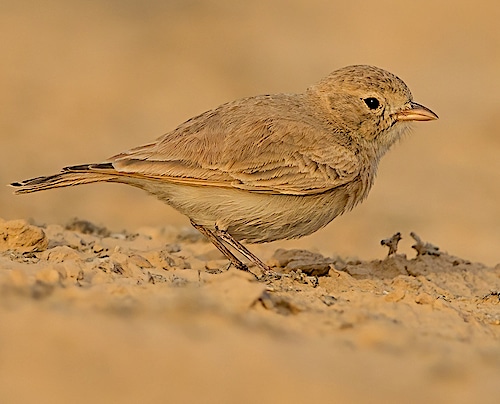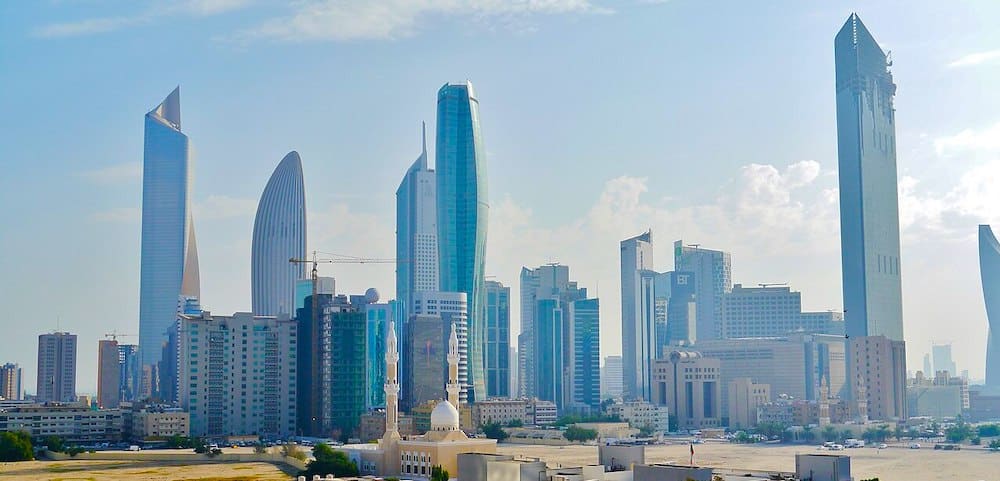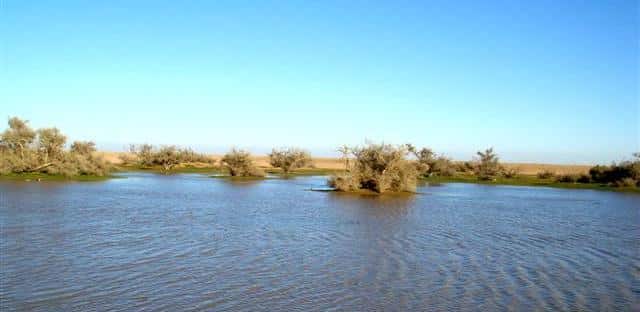State of Kuwait

Kuwait is a country in West Asia. It is situated in the northern edge of Eastern Arabia at the tip of the Persian Gulf, bordering Iraq to the north and Saudi Arabia to the south. With a coastline of around 500 km (300 miles), dominated by the large expanse of Kuwait Bay, Kuwait also shares a maritime border with Iran. Most of the country’s population (c. 75%) of around five million people reside in the urban agglomeration of Kuwait City, the capital and largest city. Less than 35% are Kuwaiti citizens while the remainder are foreign nationals from over 100 countries. The country has a surface area of about 18,000 K² and ten offshore islands in the Gulf of which only Failaka is inhabited.
The topography is flat and occasionally undulating rising from the Arabian Gulf coast up to about 300 metres in the extreme south west. The Jal Az-Zour escarpment is the only significant topographical feature running for 80km from the north shore of Kuwait Bay and reaching a maximum elevation of 145 metres.
The climate in Kuwait is characterised by very hot and dry summers and mild to cool winters. Mean temperatures are 14˚C in January and 37˚C in July. Rainfall is erratic and difficult to predict with some years experiencing over 200mm whilst less than 30mm can fall in a dry year. Most rain falls between November and May. There are no rivers in Kuwait just a few wadis such as the ‘out-of-bounds’ Wadi Al-Batin along the Iraq border in the northwest and the Wadi Ar-Rimam system inside SAANR. The nearest thing to a river is the drainage and sewage outfall into Kuwait Bay east of Jahra.

Kuwait City – ©Zairon, CC BY 4.0 via Wikimedia Commons
Vegetation is species-poor and consists of dwarf shrubs, perennial herbs and ephemerals with taller shrubs generally only being found in favoured locations such as along drainage channels. In relatively wet years the desert can become covered with a green hue as dormant plants spring to life but in dry years this is completely absent. Nomadic and semi-nomadic pastoralism are the main land uses with overgrazing by camels, sheep and goats a widespread problem. Extensive mudflats can be found around Kuwait and Sulaibikhat Bays to the east of the city and surrounding Bubiyan Island in the north, which is connected by a bridge.
Abdali, Al-Abraq Jahra and Wafra have natural oases and have been developed into traditional farm complexes often surrounded by conifer shelter belts and irrigated by wells and tanks to support a variety of crops. Urban areas are often planted with a few trees, shrubs and grass and well irrigated by sprinkler systems. These are tended by a largely immigrant workforce making urban areas green and a big attraction to migrant birds. The population is overwhelmingly concentrated in Kuwait City which has grown at a very fast rate illustrated by the building of no less than 7 rings roads at increasing distances from the city centre to accommodate the expanding city. The other main urban areas are Jahra and Ahmadi but the vast majority of the coastal strip is developed.
Twenty eight species of mammal are found in Kuwait; animals such as gerboa, desert rabbits and hedgehogs are common in the desert. Large carnivores are no longer present. Among the endangered mammalian species are red fox and wild cat. Forty reptile species have been recorded although none are endemic to Kuwait.
Birding Kuwait
Kuwait is located in the extreme south-east corner if the Western Palearctic zoological region and lays on a cross-roads – several important migration routes between continents. One of these routes runs through Kuwait en-route from the eastern Caspian Sea down through Saudi Arabia and into eastern and central Africa. Another runs from eastern Europe, through Turkey, Syria and Iraq, across Kuwait and the northern Gulf and on into Pakistan and India. A very small proportion of the total avifauna are resident or indeed breed. Of the 400+ species recorded only around 60 species actually breed including 4 tern species on Kubbar Island (Islands of ornithological interest include Kubbar and the low-lying Bubiyan to the north), wetland birds in the marshes, some dessert specialists like Bar-tailed Lark and, increasingly, birds taking advantage of the man-made habitats in cities and crop producing areas. 
Wadi Al-Batin – ©Drh104 CC BY-SA 3.0 via Wikimedia Commons
The marshes in northern Kuwait and Jahra have become increasingly important as a refuge for passage migrants; the main attraction for visiting birders is the migrants and wintering species many of which are difficult to see anywhere else in the region. These include globally threatened species such as Crab Plover, Basra Reed Warbler, Eastern Imperial Eagle and Lesser Kestrel. Other big draws are wintering Shikra and Persian Wheatear as well as Grey Hypocolius, Socotra Cormorant, Lesser Sandplover, Red-wattled Lapwing, Common Babbler, Bank Myna, Red-vented Bulbul, Egyptian Nightjar, White-throated Robin, Semi-collared Flycatcher, Bridled, White-cheeked, Swift and Lesser Crested Terns, several wheatears and shrikes and the nomadic Dunn’s Lark, Black-crowned Finch-lark and Pale Rock Sparrow.
At present, there are five protected areas in Kuwait recognised by the IUCN. In response to Kuwait becoming the 169th signatory of the Ramsar Convention, Bubiyan Island’s Mubarak al-Kabeer reserve was designated as the country’s first Wetland of International Importance. The 50,948 ha reserve consists of small lagoons and shallow salt marshes and is important as a stop-over for migrating birds on two migration routes. The reserve is home to the world’s largest breeding colony of crab-plover. Kuwaiti islands are important breeding areas for four species of tern and the Socotra cormorant. Kubbar Island has been recognised an Important Bird Area (IBA) by BirdLife International because it supports a breeding colony of white-cheeked terns.
Birders visiting Kuwait no longer require any sponsorship although a visa is required for entry. This is easily and cheaply obtained at the airport upon arrival, but be prepared for slow service and a long queue. Once there the visitor will find Kuwait to be an exceptionally affluent and largely westernised country with a low crime rate and a well-developed infrastructure.
-
Chris Lansdell
| info@oenanthe.co.uk
https://chrislansdell.blogspot.com/2012/04/kuwait-day-1-3-april-2012-manchester.html
-
Number of bird species: 418
(As at July 2024)National Bird: Golden Falcon - probably refers to a colour morph of Saker Falcon Falco cherrug
-
Avibase
PDF ChecklistThis checklist includes all bird species found in Kuwait , based on the best information available at this time. It is based on a wide variety of sources that I collated over many years. I am pleased to offer these checklists as a service to birdwatchers. If you find any error, please do not hesitate to report them. -
Birds of Kuwait
Annotated ListThe birds of Kuwait list follows OSME Region List and its nomenclature. and is validated, endorsed, and approved by Kuwait Ornithological Rarities Committee (KORC). It aims to be the most current and definitive checklist for Kuwait. It will be reviewed and updated after every KORC meeting, as new species are added and submitted Rarity Forms adjudicated. -
KuwaitBirds
ChecklistOfficial KORC Annotated Checklist of Birds here: http://birdsofkuwait.com/annotated_checklist.shtml -
Wikipedia
Annotated ListThis is a list of the bird species recorded in Kuwait. The avifauna of Kuwait include a total of 416 species, of which 8 have been introduced by humans. One species listed is extirpated in Kuwait. -
eBird
PDF ChecklistThis checklist is generated with data from eBird (ebird.org), a global database of bird sightings from birders like you. If you enjoy this checklist, please consider contributing your sightings to eBird. It is 100% free to take part, and your observations will help support birders, researchers, and conservationists worldwide.
-
Birds of the Middle East
| By AbdulRahman Al-Sirhan, Jens Eriksen & Richard Porter | Helm | 2022 | Paperback | 224 Pages, 400 Colour Photos | ISBN: 9781472986757 Buy this book from NHBS.com -
Birds of the Middle East
| By Richard Porter, Oscar Campbell & AbdulRahman Al-Sirhan | Helm | 2024 | Edition 3 | 400 pages, 180 colour plates, 636 colour distribution maps | ISBN: 9781399401968 Buy this book from NHBS.com -
Birds of the State of Kuwait
| By George Gregory | George Gregory | 2005 | Paperback | 219 pages, colour photos | ISBN: 9780955141607 Buy this book from NHBS.com -
The Birds of Kuwait
| By A Sadiq, Al-Haddad & FA Al-Sidrawi | 2002 | Paperback | 252 pages, Col photos, dist maps, tabs | ISBN: 9789990632743 Buy this book from NHBS.com
-
Bird Monitoring and Protection Team (BMAPT)
WebsiteThe Bird Monitoring and Protection Team (BMAPT) has the aims of monitoring and protecting both resident and migratory birds in Kuwait. Its functions include recording both common and rare birds, taking biometrics, monitoring birds in nature reserves and elsewhere, establishing and managing new reserves, and increasing public awareness of birds in Kuwait and of the necessity of protecting them. It is committed to the free flow of information about birds in Kuwait, and to close cooperation with Kuwait governmental bodies, and international ornithological and bird protection organizations -
BirdLife
WebsiteLocated at the south-east corner of the western Palearctic realm, Kuwait possesses a fairly rich avifauna despite its small size and harsh climate, with more than 280 species having been recorded; however, probably only 16 species breed on the mainland and only eight of them regularly, the rest being passage migrants or winter visitors. Species from the adjacent Indo-Malayan and Afrotropical realms from minor components of the avifauna, but records indicated. -
Kuwait Birds
WebsiteThis site is about wild birds in Kuwait: learning them, enjoying their beauty and observing them in nature. This nature conservation project developed by Biodiversity East and sponsored by Kuwait Foreign Petroleum Exploration Company (KUFPEC). -
Kuwait Environmental Protection Society
WebsitePO Box 1896, Safat 13019, Kuwait In Arabic & English - Working to create an environmental and scientific method of public thinking in order to establish the necessary remedial legislation for the protection of environmental against pollution…
-
NR Al-Jahra Pool
WebpageSatellite ViewThe only significant area of non-marine wetland in the country, man-made by effluent (sewage plus a variety of pollutants) coming from Al-Jahra town and flowing across sandy sabkhah to the sea, forming stagnant, open, shallow pools and extensive beds of Phragmites. There are scattered halophytes on the sabkhah, and some old plantations of Tamarisk in poor condition. -
NR Sabah Al-Ahmad
eBird VisitsSatellite ViewThe Sabah Al-Ahmad nature reserve occupies land that once served as an important base for Saddam Hussein's army during its invasion of Kuwait from 1990-1991. -
Parks, Reserves, and Other Protected Areas
InformationSatellite ViewThe Protected Areas Division, together with the Wildlife Development Division and the Marine Organism Monitoring Division, is part of the Living Resource Department of the Environment Public Authority (EPA) of Kuwait. -
Wetlands
WebpageSatellite ViewKuwait currently has one site designated as a Wetland of International Importance (Ramsar Sites), with a surface area of 50,948 hectares
-
AbdulRahman Al-Sirhan Alenezi - Birds of Kuwait
GuideWelcome to the Kuwait Birdwatching Tours. We offer the best birdwatching and bird guiding tours in the Eastern Southern corner of the Western Palearctic. Thus, we have several bird specialties. -
Rockjumper
Tour OperatorEmbark on an unforgettable bird-watching expedition as we explore the diverse landscapes and rich avian habitats of Kuwait and Saudi Arabia. Over the course of 15 days, we expect to encounter an incredible diversity of species including virtually all the Arabian Peninsula endemics, including several rarely-seen species, and three sought-after bird families (Hypocolius, Scrub-warbler, and Crab-plover). Furthermore, our tour is timed to coincide with the northward Palearctic migration boosting the list of probable species even further. -
Zoothera Birding
Tour OperatorFor the avid Western Palearctic lister, Kuwait is a mouth-watering, list building mega country, offering numerous special birds unique to this country or are extremely hard to find elsewhere. It's a relatively small country, so we stay in one hotel for the 8 nights, making day trips to all the best birding hotspots.
-
2015 [04 April] - Nigel Warren
PDF Report...http://www.birdfinders.co.uk/pdf/kuwait-spring-2015.pdf... -
2015 [12 December] - Derek Charlton
Report...We soon found that White-cheeked Bulbul, Marsh Harrier, Common Myna, Isabelline Shrike, Water Pipits, Black Kite and Laughing Doves were all common in the appropriate habitat.... -
2017 [12 December] - Pekka Fagel & Peter Lansdown
PDF ReportAny birding trip has its highs and lows and in this respect Kuwait was quite normal, but the fact that one experienced birder gained 12 life ticks made this tour exceptional and our appreciation for Pekka and Peter enduring the frustrations of Kuwait bureaucracy was undeniable. -
2018 [04 April] - Christian Andersen Jensen
PDF ReportThe purpose with this report is to give inspiration to others who plan to go birding in Kuwait and to share our experience -
2019 [04 April] - ABDULRAHMAN AL-SIRHAN
PDF ReportLaughing Dove Streptopelia senegalensis 1, Pallid Swift Apus pallidus 5, White-throated Kingfisher Halcyon smyrnensis 1, Eurasian Wryneck Jynx torquilla 1, Ring-necked Parakeet Psittacula krameri 2, Barn Swallow Hirundo rustica 6, Common Grasshopper Warbler Locustella naevia 1, Eurasian Blackcap Sylvia atricapilla 10, Semicollared Flycatcher Ficedula semitorquata 1, Common Redstart Phoenicurus phoenicurus 1, Common Myna Acridotheres tristis 17, Bank Myna Acridotheres ginginianus 4, Tree Pipit Anthus trivialis 3, House Sparrow Passer domesticus 35. -
2023 [12 December] - Brian McCloskey
PDF Report...Species like Grey Hypocolius and Afghan Babbler were some of our most wanted species, however, my main target for this trip was the Indian Roller... -
2023 [12 December] - Jeff Hopkins
PDF Report...There were a few birds at the top of a nearby tree that turned out to be bulbuls, but AbdulRahman noted the Hypocolius (Hypocoliuses? Hypocolii?) were in the same tree. Eventually, they climbed into the open and I got a great look at my main target, the Hypocolius...
-
Photographer - Alsirhan
GalleryBirds of Kuwait [plus other flora and fauna] -
Photographer - Rashed al Hajji
FlickR -
Photographers
GalleryThe Kuwait Bird Photo Gallery includes all the birds from Kuwait Bird List. More photos will be added to include all plumages of Kuwait’s Birds. Scroll down or search for a species and click on a species’s photo or its caption to see its gallery. Currently, it includes all photos from past blogs (from 2007 to 2020), but more photos will be added at a later stage.

